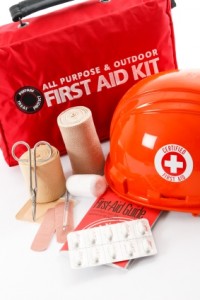 If you haven’t given your company’s safety policies some careful thought lately, you are making a big mistake. Failure to adhere to prevailing workplace safety guidelines subjects you to legal liability that can cause you to incur fines and leaves your employees at risk for accidents and injuries.
If you haven’t given your company’s safety policies some careful thought lately, you are making a big mistake. Failure to adhere to prevailing workplace safety guidelines subjects you to legal liability that can cause you to incur fines and leaves your employees at risk for accidents and injuries.
Creating and maintaining a workplace safety plan not only helps to protect a business from lawsuits, it fosters an environment where employees feel valued, knowing that their best interest is being looked after. In assessing your workplace safety plan, think carefully about steps to help prevent accidents as well as procedures to deal with an incident after it occurs.
Items to Prevent Accidents and Injuries
Safety Gear. Employers should require employees to dress appropriately based on their job responsibilities. While office workers may not need a strict dress code, employees who work in dangerous environments need specific Personal Protective Equipment (PPE). For those employees, companies should make available adequate safety gear, such as safety goggles, face shields, hard hats, and protective gloves. In addition, if air quality issues are a concern, employees must have access to respirators. In noisy workplaces, companies should also have earplugs available to prevent hearing damage.
Cleaning Products. Promoting cleanliness yields safety and wellness benefits. Keeping your office or facility in a clean, sanitary condition will contribute to the prevention of illness, which is important to a healthy, productive staff. In addition, eliminating clutter around the workplace prevents slips, trips, and falls, particularly around doors; and poorly light areas. All exits should also remain unobstructed at all times.
Signs. Employers should display posters and signs throughout the office to communicate important safety information. Any dangerous areas of the facility must contain warnings to notify employees about the specific hazards. Also, those employers subject to regulations promulgated by the Occupational Safety Health Administration, or OSHA, must post certain notices for employees, including marking places at a worksite where caution should be exercised, perhaps near an overhang where workers could potentially fall. Some states have policies that are more restrictive than OSHA’s, so familiarizing yourself with state and local laws is important. If all your employees do not speak English, OSHA offers some of its materials in a variety of different languages.
Items to Use in Reacting to an Accident or Injury
Fire Materials. Local laws in most jurisdictions require companies to have portable fire extinguishers, and many buildings have sprinklers, fire alarms, and smoke detectors. Although alarms are great to alert employees of an emergency, if your workplace is noisy or if any member of the staff is hearing impaired, those alarms should also have flashing lights included for maximum safety.
Proper Lighting. If the power goes out as a result of weather or some other emergency, an alternative power source should be available to provide ample illumination for exits. Although an automatic standby generator costs more than a gas model, they turn on automatically in case of an emergency power failure. Also, opt for flashlights (instead of candles, which could be a workplace hazard themselves) to be kept on hand for use in the event of a power outage.
First Aid Kits. First aid kits are great resources for minor scrapes or burns, and they can also provide lifesaving temporary treatment while waiting for EMS if a major injury occurs. Companies should ensure that an adequate number of first aid kits are available based on the number of employees and the layout of the workplace. For example, no one should have to travel down numerous flights of stairs just to get access to medical supplies. Employers must also routinely replenish the contents of their first aid kits and inspect medications to make sure they have not expired.
A safe workplace starts with your employees’ mindsets. Having the right equipment and information on hand creates an environment where it’s obvious that each worker’s individual well-being is valued.
At Safety Services Company the team run by Jay Acker makes materials for conducting weekly safety meetings, safety training programs, posters and other items.